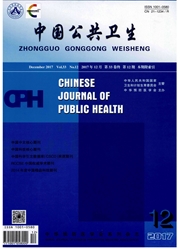

 中文摘要:
中文摘要:
目的观察补充不同剂量碘化钾(KI)对Wistar大鼠血液抗氧化能力的影响。方法将Wistar大鼠随机分为6组:低碘组(LI)、适碘组(NI)、5倍高碘组(5HI)、10倍高碘组(10HI)、50倍高碘组(50HI)、100倍高碘组(100HI)。喂养3,6,12个月后,检测血液中的谷胱甘肽过氧化酶(GPx)活性、超氧化物歧化酶(SOD)活性以及丙二醛(MDA)含量。结果LI组GPx活性在3个月和6个月时均低于NI组(P〈0.01)。MDA含量在6个月时较NI组增高(P〈0.05)。LI组SOD活性与NI组比较差异无统计学意义(P〉0.05)。在实验3个月时,100HI组较NI组GPx活性降低(P〈0.01);在实验3个月、6个月和12个月时,4个高碘组SOD活性和MDA含量与NI组比较差异无统计学意义(P〉0.05)。结论低碘导致大鼠血液抗氧化能力降低;血液的抗氧化系统对高碘有一定的耐受能力;血液有较强的抗氧化能力和代偿能力。
 英文摘要:
英文摘要:
Objective To study the effect of different dosage KI on the anti - oxidative capability of blood. Methods The rats were divided into 6 groups and given by different dosage of KI, which were low iodide (LI), normal iodide (NI), 5 fold high iodide (5HI), 10 fold high iodide (10HI), 50 fold high iodide (50HI) and 100 fold high iodide (100HI). Three, 6 and 12 months later, the rats were sacrificed and blood glutathione peroxidase (GPx) activity, superoxide dismutase (SOD) activity and malondialdehyde (MDA) content were measured. Results After treatment for 3 and 6 months, the GPx activity in LI group was markedly lower than that in NI group. Furthermore, after 6 months for low iodine intake, the MDA content in LI group was higher than that in NI group. The GPx activity in 100HI group was lower than that in NI group after administration for 3 months, but no difference between these two groups after treatment for 6 and 12 months, no difference was found in the GPx activity of NI group and those of 5HI, 10HI and 50HI groups. There was no difference in SOD activity and MDA content among NI group and 4 high iodide groups. Conclusion Low iodide intake would damage the anti - oxidative capability of blood in normal rats. Blood had a strong anti - oxidative ability and compensative capabilities to compete with high iodide intake.
 同期刊论文项目
同期刊论文项目
 同项目期刊论文
同项目期刊论文
 期刊信息
期刊信息
